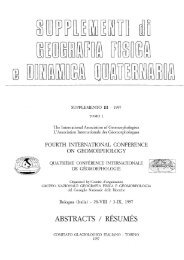Full Text (PDF)
Full Text (PDF)
Full Text (PDF)
You also want an ePaper? Increase the reach of your titles
YUMPU automatically turns print PDFs into web optimized ePapers that Google loves.
UMBRO-ETRUSCAN PERIOD<br />
Between the 9th and the 3rd Century BC, the Umbrians<br />
generally lived on the left side of the Tiber in scattered<br />
villages (Pagus) on the mountains and hills (Colfiorito)<br />
(Feruglio & alii, 1991). The Etruscans lived mostly on the<br />
right side, but they were present also on the left side, and<br />
contacts and fights between the two peoples are documented.<br />
It was usually the Etruscans who crossed the<br />
Tiber and came into conflict with the Umbrians.<br />
There are no documents concerning the Valle Umbra<br />
that testify to any active human dwelling on the floor of the<br />
valley. Archaeological remains come from mountain areas<br />
(Hurvinium Hortense), hills (Bettona, Trevi) or at least from<br />
slightly elevated areas (Mevania, Fulginium) (Feruglio & alii,<br />
1991; Bonomi Ponzi, 1991; Baiolini, 2002; Barbieri, 2002).<br />
It is therefore realistic to suppose that the valley was unhealthy,<br />
since it was covered alternately with lakes, swamps<br />
or marshes caused by the rainy and cold climate (fig. 4).<br />
Some historians refer to two lakes – Lacus Umber and Lacus<br />
Clitorius – which occupied a large part of the valley<br />
(Pietrangeli, 1953). There is evidence of dwellings only on<br />
elevated areas. The archaeological ruins close to Collemancio<br />
are mainly Roman (Hurvinium Hortense), but recently<br />
foundations have been found which seem to be Etruscan. In<br />
Trevi, several remains from the Umbrian period are documented,<br />
antecedent to the Roman settlement (Zenobi,<br />
1995), and the same is true in Spello, Assisi, elsewhere.<br />
ROMAN PERIOD<br />
The Romanisation of the Valle Umbra began around<br />
the 3rd Century BC, while the climate was still cold and<br />
FIG. 4 - Valle Umbra swamps:<br />
hypothetical landscape interpretation<br />
of the marsh/swamp environment<br />
of the south-eastern<br />
arm of Tiberino Basin during late<br />
Pliocene (drawn by A. Speziale).<br />
humid (fig. 5). At first the Roman settlements were on the<br />
hills: as already mentioned, in a place called Hurvinium<br />
Hortense – close to Collemancio – at an elevation of 520<br />
meters, the remains of a temple and of a mosaic have been<br />
discovered together with a Roman village. Here a modern<br />
elliptical olive-grove has the same geometrical proportion<br />
of a Roman amphitheatre (Camerieri, 2006) (fig. 6) and<br />
along the perimeter, remains of Roman substructures have<br />
been excavated. It is remarkable that after 2000 years the<br />
outline of a Roman structure is still evident, even if in a<br />
quite different context.<br />
The settling on the hill supports the hypothesis that<br />
the valley floor was uninhabitable (Manconi, 1985). In the<br />
same period historians report the Lacus Umber and Lacus<br />
Clitorius were extensive and one of them as deep as 5 metres<br />
(Dragoni, personal communication).<br />
From the 2nd Century BC onwards there is a fervent<br />
and dynamic Romanization of the valley. The outstanding<br />
cultural heritage of this period can be seen in numerous<br />
places all over the region. This period lasted right up to<br />
the 3rd Century AD.<br />
The following list shows the evidence which exists today<br />
on the ground.<br />
a) Centuriation: centuriation is the subdivision of the<br />
land, with exactly perpendicular boundaries. The «centuriae»,<br />
were farms created both to reward legionaries and<br />
veterans for their military service, and also to tie the legionaries<br />
to the land in order to create a population ready<br />
to defend this land from external attacks. Some present<br />
farm boundaries still partially follow the lines of these ancient<br />
subdivisions; landmarks and towers also in many cases<br />
conform to these divisions. There are also centurial divi-<br />
111















